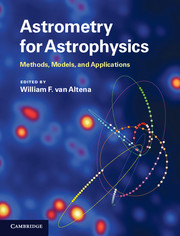Book contents
- Frontmatter
- Contents
- List of contributors
- List of acronyms
- Preface
- Part I Astrometry in the twenty-first century
- Part II Foundations of astrometry and celestial mechanics
- Part III Observing through the atmosphere
- Part IV From detected photons to the celestial sphere
- Part V Applications of astrometry to topics in astrophysics
- 22 Galactic structure astrometry
- 23 Binary and multiple stars
- 24 Binaries: HST, Hipparcos, and Gaia
- 25 Star clusters
- 26 Solar System astrometry
- 27 Extrasolar planets
- 28 Astrometricmeasurement and cosmology
- Index
- References
24 - Binaries: HST, Hipparcos, and Gaia
from Part V - Applications of astrometry to topics in astrophysics
Published online by Cambridge University Press: 05 December 2012
- Frontmatter
- Contents
- List of contributors
- List of acronyms
- Preface
- Part I Astrometry in the twenty-first century
- Part II Foundations of astrometry and celestial mechanics
- Part III Observing through the atmosphere
- Part IV From detected photons to the celestial sphere
- Part V Applications of astrometry to topics in astrophysics
- 22 Galactic structure astrometry
- 23 Binary and multiple stars
- 24 Binaries: HST, Hipparcos, and Gaia
- 25 Star clusters
- 26 Solar System astrometry
- 27 Extrasolar planets
- 28 Astrometricmeasurement and cosmology
- Index
- References
Summary
Introduction
Hipparcos (see ESA 1997), launched in 1989, repeatedly observed the whole sky for about 3.5 years but only measured a pre-selected sample of stars (˜ 120000). The typical positional precision at the end of mission is of the order of one milliarcsecond (mas). Although it was primarily an astrometric mission, its on-board photometer also yielded some sparse light curves of eclipsing binaries. All astrometric observations are one-dimensional measurements, whether the observations are those of a resolved or unresolved binary, or a single star. That measurement is the separation between some reference point and the target projected along the scanning direction (which changes continuously). With a primary mirror of 30 cm operating in the visible (up to V ˜ 12 mag), its resolving power was not that impressive (about 0.5″).
The Hubble Space Telescope (HST) is a pointing instrument launched by NASA in 1990. The main instrument for binary observation (and astrometry in general) is the Fine Guidance Sensor (FGS, see Benedict et al. 2008). Two out of the three FGSs lock onto guide stars while the science FGS observes the target with a single-measurement precision of 1 mas.
Gaia, yet another European Space Agency (ESA) mission, will be launched in 2013. Although it will include a spectrograph, primarily for radial-velocity determination, as well as a photometer operating in two distinct bands, Gaia will be based on the same principles as Hipparcos, namely a spinning and precessing instrument with two pointing directions with a large angular separation.
- Type
- Chapter
- Information
- Astrometry for AstrophysicsMethods, Models, and Applications, pp. 355 - 359Publisher: Cambridge University PressPrint publication year: 2012



